Food & Drink ESL Activities, Games & Worksheets
My Shopping List

ESL Food and Drink Activity - Vocabulary: Matching, Listing, Identifying - Pair Work
In this free food and drink vocabulary activity, students match food and drink words to pictures and review the vocabulary in a dictation game. First, students match each word to a food and drink picture and write the word underneath. Students...
Chow Challenge

ESL Food and Drink Board Game - Vocabulary and Speaking: Multiple-Choice Questions, Guessing, Freer Practice - Group Work
Here is an engaging food and drink board game to help students practice a variety of vocabulary related to food and drink. Players take turns rolling the dice and...
Food and Drink Challenge

ESL Food and Drink Games - Vocabulary and Speaking: Matching, Pelmanism, Forming Sentences, True or False, Guessing, Freer Practice - Pair Work
Here are two food and drink games to help students practice the names of common foods and drinks. First, students play a pelmanism game where they match...
Food and Drink Habits

ESL Eating Habits Activity - Speaking: Asking and Answering Questions, Freer Practice
In this insightful eating habits speaking activity, students ask and answer present simple questions about eating and drinking habits. Students start by reviewing prompts on the worksheet and forming...
Food Question Time
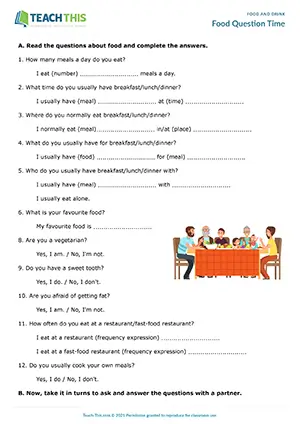
ESL Eating Habits Activity - Vocabulary and Speaking: Gap-fill, Sentence Completion, Asking and Answering Questions, Controlled and Freer Practice - Pair Work
In this productive eating habits speaking activity, students ask and answer food-related questions. Working alone, students read questions about food on...
Fruity Fun

ESL Fruit Worksheet - Vocabulary Exercises: Matching, Gap-fill, Binary Choice, Multiple Choice, Ranking, Answering Questions
Here is a comprehensive fruit worksheet to help students learn and practice fruit vocabulary. First, students match fruit words from a box with pictures. Students then complete descriptions with...
Fun with Food

ESL Food and Drink Worksheet - Vocabulary Exercises: Categorising, Gap-fill - Speaking Activity: Asking and Answering Questions, Controlled and Freer Practice - Pair Work
This detailed food and drink worksheet helps students practice vocabulary related to food and drink. First, students match halves to make sentences about...
Restaurants and Cafes
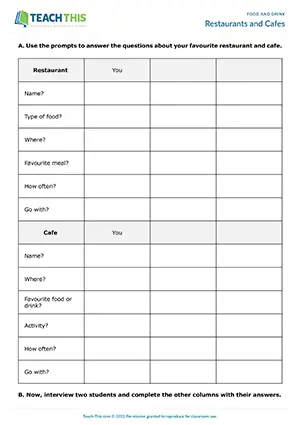
ESL Eating Out Activity - Speaking: Asking and Answering Questions, Controlled and Freer Practice - Group Work
In this engaging eating out speaking activity, students ask and answer questions about their favourite restaurants and cafes. To begin, students go through the prompts on the worksheet and form the...
Cooking Verbs

ESL Cooking Verbs Game - Vocabulary: Brainstorming, Word Association, Spelling - Pair Work
This handy cooking verbs game is ideal for practicing verbs related to cooking and food vocabulary. In pairs, students have ten minutes to brainstorm and write down all the food words they can think of...
Eating Habits

ESL Eating Habits Questionnaire - Speaking Activity: Asking and Answering Questions - Pair Work
In this free eating habits questionnaire, students ask and answer questions about eating habits. In pairs, students take it in turns to ask and answer questions about eating habits and write their partner's...
Fruit and Veg Game

ESL Fruit and Vegetables Game - Vocabulary: Describing, Guessing - Group Work
In this enjoyable fruit and vegetables game, students describe fruit and vegetables for other students to guess. In groups, students take it in turns to pick up a card and describe the fruit or vegetable on the...
Fun Food Challenge
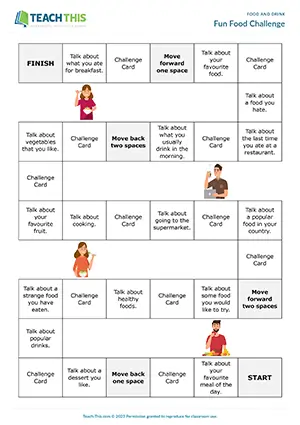
ESL Food and Drink Board Game - Vocabulary and Speaking: Impromptu Speech, Listing, Freer Practice - Group Work
In this fun food and drink board game, students practice talking about food and drink using topic-related vocabulary. Players take turns rolling the dice and moving their counters along the board...
Make a Menu

ESL Menu Worksheet - Vocabulary Activity: Naming and Listing
In this imaginative menu worksheet, students create a restaurant menu, showing dishes they like to eat along with the price and ingredients of each dish. Students start by thinking of a name for their restaurant and writing it at the top of the...
Name Two...
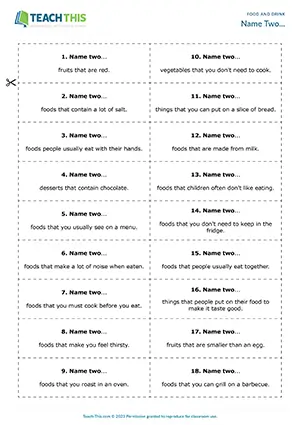
ESL Food and Drink Game - Vocabulary: Providing Vocabulary - Group Work
In this fun food and drink game, students race to name food and drink vocabulary that matches 'Name two...' prompts. In groups, students take turns picking up a card and reading the 'Name two...' prompt to the other students, e.g. 'Name two...
Containers and Amounts
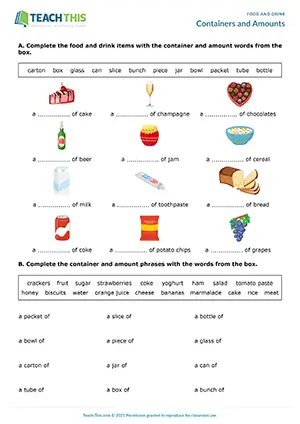
ESL Containers and Amounts Worksheet - Vocabulary Exercises: Matching, Gap-fill
This free containers and amounts worksheet helps you to teach your students about containers and amounts that go with food and drink items. Students begin by completing food and drink items with container and amount words from a box...
Food Adjectives
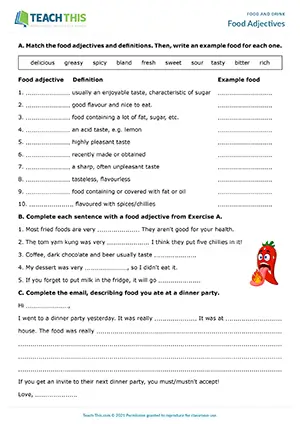
ESL Food Adjectives Worksheet - Vocabulary and Writing Exercises: Matching, Gap-fill, Writing Sentences
In this comprehensive food adjectives worksheet, students learn about food adjectives and write an email, describing food at a dinner party. Students begin by matching food adjectives with...
Food and Cooking Survey

ESL Food and Cooking Survey - Speaking Activity: Asking and Answering Questions, Freer Practice
In this interesting food and cooking speaking activity, students conduct a survey where they ask and answer yes/no questions about eating and cooking habits. The students' task is to find out the information on...
Food for Thought
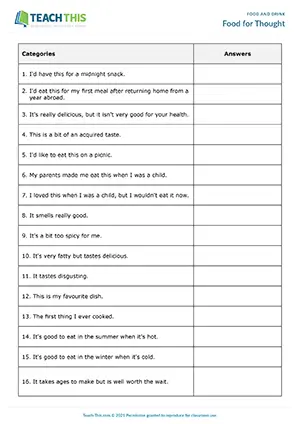
ESL Food Discussion Activity - Speaking: Discussion, Asking and Answering Questions, Freer Practice - Group work
In this useful food discussion activity, students write about and discuss types of food and dishes. First, students read the categories on the worksheet and write an example of a food or dish...
Fruit and Vegetable Games

ESL Fruit and Vegetable Games - Vocabulary: Pelmanism, Matching, Naming - Pair Work
These free fruit and vegetable games help students learn the names of fruit and vegetables. To begin, students play a pelmanism game where they take it in turns to turn over a vocabulary card...
School Lunches

ESL Food and Nutrition Activity - Vocabulary and Speaking: Categorising, Table Completion, Comparing, Discussion, Answering Questions - Group Work
In this creative food and nutrition activity, students categorize food items and plan a school lunch menu. First, students categorize food items on their worksheet...
Food and Drink Collocation Dominoes
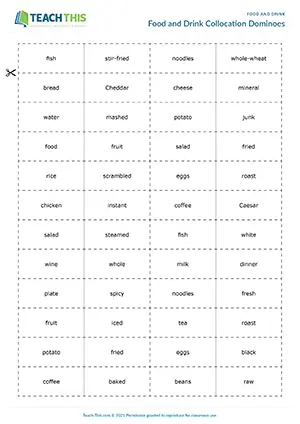
ESL Food and Drink Collocations Game - Vocabulary: Matching
In this entertaining food and drink collocations game, students play dominoes by matching adjectives and nouns together to form food or drink collocations and then using each collocation in a sentence. The first player puts a domino down either...
Food Frenzy Board Game

ESL Food Board Game - Vocabulary and Speaking: Gap-fill, Impromptu Speech, Freer Practice - Group Work
This memorable food board game helps students practice verbs, adjectives and nouns related to food and drink. Players take turns rolling the dice and moving their counters along the board. If a player...
Disappointed Diners

ESL Food Adjectives Activity - Vocabulary: Information Gap, Table Completion, Gap-fill - Pair Work
In this rewarding food adjectives activity, students practice food words and adjectives by racing to complete information about problems people had with something they ate or drank. To begin, students...
Gone in 30 Seconds

ESL Food Game - Vocabulary and Speaking: Impromptu Speech - Pair Work
In this inventive food vocabulary game, students talk about food-related words for 30 seconds. This game covers food adjectives, cooking verbs and other food vocabulary. Teams begin by adding five food-related words to their grid. Teams...
Pizza and Pancakes

ESL Recipes Activity - Vocabulary and Speaking: Gap-fill, Asking and Answering Questions - Group and Pair Work
In this intriguing recipes activity, students complete recipes with cooking verbs. In two groups, students look at the first recipe on their worksheet and use verbs in a box to complete the recipe...

